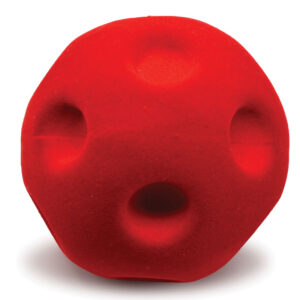Concentration
A young infant practices focusing on an object manipulated by a caregiver.



Be Prepared: Select a block that has a bold color or texture that will appeal to the infant.
[Hold the infant in your arms with his/her head well supported in the bend of your arm. Make sure the infant can clearly see you.
Hold the block about 12 inches from the infant and begin moving it slightly from side to side.]
Do you see our block?
[Pause for and acknowledge the infant’s response. Example: “You are watching the block, Ximena. The block is moving back and forth.”
Slowly move the block a little farther from side to side while keeping it within the infant’s line of vision. Describe the infant’s response. Example: “You are moving your eyes. You are watching the block move.”
Slowly move the block toward the infant’s middle and hold it steady so the infant can touch it. Encourage the infant to touch or grasp the block. If the infant is not able to grasp the item, hold it near the infant’s hands so he/she can touch it. Continue to describe the infant’s actions and respond to vocalizations. Example: “I hear you talking! You are cooing. I think you like touching the block.”]
[Smile and make eye contact as you describe what happened. Example: “We played with a red block today. You watched the block move back and forth. You touched the block. It felt soft.”]
Concentration
An older infant practices focusing on objects as part of open-ended play with a caregiver.



This activity is for an infant who can sit independently or with support. Invite an infant to join you on the floor to play with blocks. Sit across from the infant. Place two blocks in front of you and put the remaining blocks next to your side or behind you.
Place the blocks in several different arrangements, such as putting the blocks next to each other, or stacking the blocks. Describe what is happening with the blocks and acknowledge the infant’s attention to the blocks. Example: “You are looking at our blocks. Our blocks are making a little tower.”
Hand the two blocks to the infant and invite him/her to play with the blocks. Describe what the infant does with the blocks. After a period of exploring the two blocks, offer the infant 1–3 more blocks. The infant may incorporate the additional blocks into his/her current uses of two blocks or create a different arrangement. An older infant may want to stack the blocks. Assist if the infant asks for help. He/she may ask for help by looking at you, or reaching toward you, or handing a block to you.
Continue to acknowledge the infant’s actions and reactions. Example: “You laughed when the blocks fell down!” Conclude the activity when the infant begins to lose interest. Emphasize how the infant looked at and played with the blocks. Example: “We had fun playing with the blocks, William! You watched me put the blocks in different ways. Then you played with the blocks. You made a big tower and knocked it over!”
Blocks are a good material to use for helping infants strengthen their skills in paying attention. They provide many open-ended play opportunities and are often a favorite of infants and older children. The length of a session will vary considerably across infants. Infants may show disinterest in customary ways, such as looking away, fussing, squirming, or crawling/walking away. The ways in which an infant provides attention also will vary, especially in Option 1 where an infant’s gaze may be the primary or only way of giving attention. Positively recognize any and all forms of remaining engaged with the blocks.
Extra support
Enrichment
Materials Needed: assortment of soft blocks
Provide an assortment of blocks for infants to play with during floor time. Begin stacking or lining up some of the blocks to engage one or several nearby infants. Describe your actions with the blocks to encourage infants to notice your arrangement. Older infants may enjoy knocking down a tower of several blocks. Give each young infant a block to touch and hold.
 Materials Needed: soft ball in a bold color
Materials Needed: soft ball in a bold color
Invite older children to gather in a circle and pass the ball around the circle. Hold an infant on your lap as you sit in the circle with the children. Encourage the infant to watch the ball as it is passed around the circle. Show enthusiasm when it is the infant’s turn to hold and then pass the ball. Older children may enjoy music playing as they pass the ball.